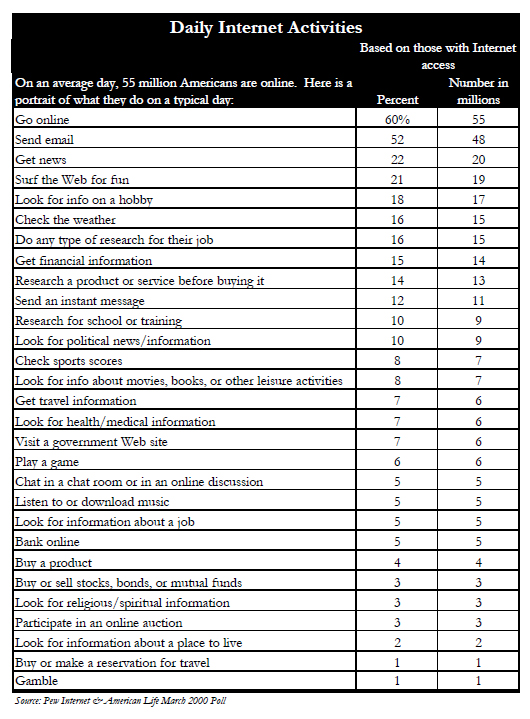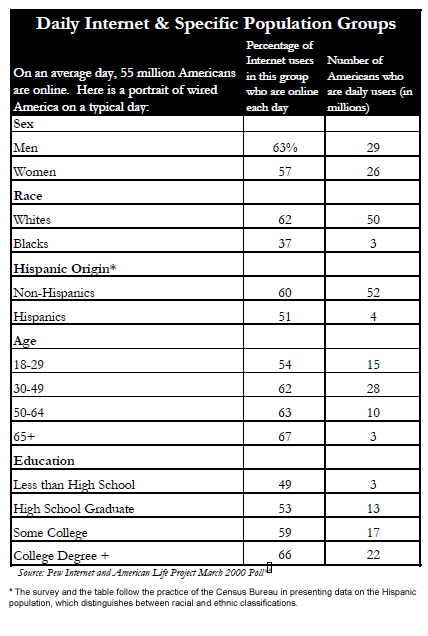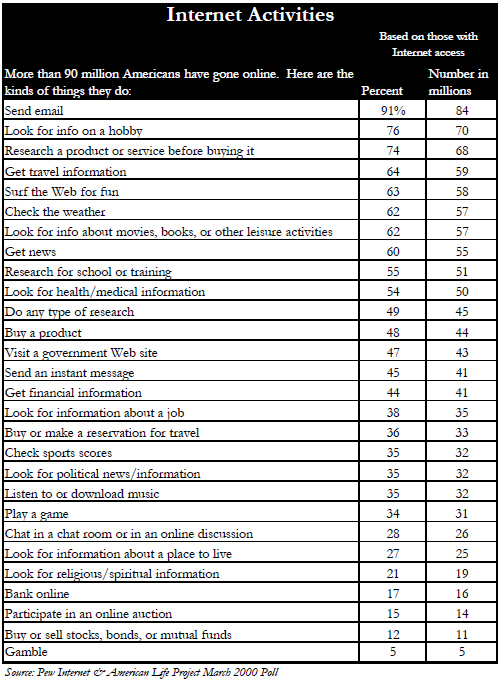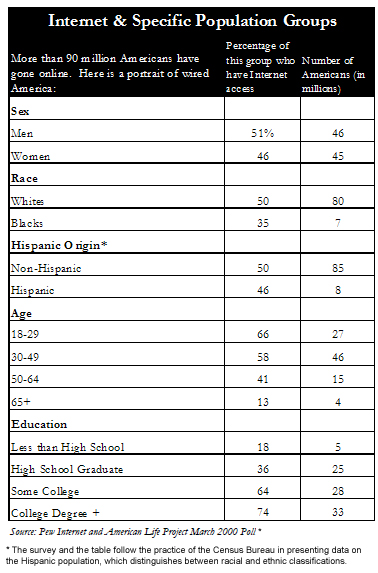Tracking online life
Women’s different online lives:
More than 9 million women have gone online for the first time in the last six months and this surge has led to gender parity in the Internet population. It has also reshaped America’s social landscape because women have used email to enrich their important relationships and enlarge their networks. The Internet has the opposite of an isolating effect on these users. They report that email has helped them improve their connections to relatives and friends. More than men, women say they are attached to email and pleased with how it helps them.
- 55% of Internet users say their email exchanges have improved their connections to family members — 60% of women assert that; 51% of men say that
- 59% of those who email family members report they communicate more often with significant family members now that they use email — 61% of women say that; 56% of men say that
- 66% of Internet users say email has improved their connections with significant friends — 71% of women assert that; 61% of men say that
- 60% of those who email friends report they communicate with significant friends more often now that they use email — 63% of women assert that; 54% of men say that
- 49% of email users say they would miss email a lot if they could no longer use it — 56% of women say that; 43% of men say that
Connecting the family, extending it, and celebrating it
Internet tools broaden users’ social worlds. In general, Internet users have more robust social lives than non-users and the most fervent Internet users are the ones who more frequently say email use has improved their bonds with relatives. Millions have used the Internet to rekindle relationships and locate long lost relatives and friends. They also report that they have learned more about their families on the Web.
- 26 million Americans have used email to start communicating regularly with a family member with whom they had not previously had much contact
- 24 million have use the Web and email to locate or hunt for family or friends they had lost touch with
- 16 million say they have learned more about their families since they began using email
- 30 million are members of families in which someone has created a family Web site
- 54 million belong to a family where someone in the family has used the Internet to research their family history or genealogy
Changing communication patterns:
The use of email is changing how some families interact. It has increased communication in some relationships and perhaps been used as a substitute for conversation in others.
- 62% of those who email relatives say they like email because they can stay in touch without having to spend so much time talking to them
- 72% of those who email friends say they like email because they can stay in touch with friends without having to spend so much time talking to them
- 31% of family emailers contend it is easier for family to say frank or unpleasant things in email than in conversation and most of them say blunt emails are good for their family
- 34% of those who email friends say it is easier to say frank or unpleasant things in electronic missives to friends – 37% of men say that; 30% of women say that
Some family communications now revolve as much or more around email as they do on conversation.
Among those who email a family member, 40% communicate with that person by email more than they phone
Siblings who have an email relationship send email much more often than they phone each other – 69% of these siblings email each other once a week or more often; 44% of them phone their siblings that often
Parents and children who email each other regularly now communicate online as often as they talk by phone – more than 75% of parents and children who email each other talk on the phone once a week or more often and they email each other with the same frequency
Daily activities on the Internet:
Email is not the Internet’s only “killer app.” Today, the number of Americans who seek information or complete transactions on the Web each day is the same as the number of those who communicate with email. On a typical day online 55 million Americans log on to the Internet, 48 million Americans send or read email, and 48 million Americans perform at least one activity on the Web.
On the Web, the gender gap is quite pronounced in some places. Women are more likely to seek health information, get religious information, research new jobs, and play games online. Men are more likely to use the Web to get news, shop, seek financial information and do online stock trading, participate in online auctions, access government Web sites, and search for sports news.
At the same time, there are a striking number of online activities that are performed in equal measure by men and women. These often involve Web activities that are very popular with young adults. Many of these activities probably attracted young men and women to the Web in the first place. The Internet’s special communications methods like chat rooms and instant messages are used in equal proportion by men and women. Browsing the Web for fun is a leisure pursuit for twenty-somethings of both sexes. There is no gender-based difference in use of the Web when it comes to doing school-related research or job-related research. The Web is a popular tool among the young of both sexes for accessing popular culture by downloading music or getting information about movies, books and other leisure activities. And convenience activities online such as arranging travel and banking are also equally popular with men and women.
Tracking online life: Methodology and results
This report is built on the findings of an innovative tracking survey of Internet activities, which was designed to get an accurate reading on the impact of the Internet on Americans’ lives. Running continually since March 1, 2000, the daily poll has asked thousands of Internet users not only about what they have ever done online, but also about what they did “yesterday.” Using a daily sample design, this approach measures the scope of Internet activities more accurately than conventional surveys because it focuses on activities that are fresh in respondents’ minds. It also provides new insights into the range of online behavior that occurs daily. Overall, here is the picture of an average day on the Internet that emerges from the Internet Life survey, which involved interviews in March with 3,533 Americans, some 1,690 of whom are Internet users:






